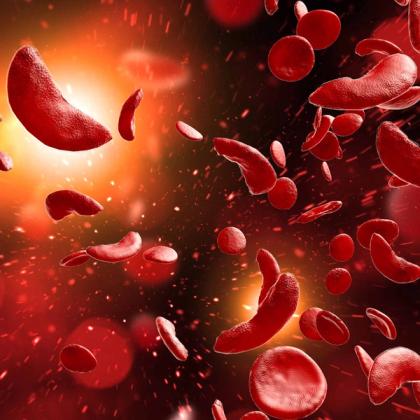Sickle cell anaemia is a disease of red blood cells, caused by an autosomal recessive single gene defect in the beta-chain of haemoglobin, which results in production of sickle cell haemoglobin. Sickle cells can obstruct blood flow and break down prematurely, and they are associated with varying degrees of anaemia. A common presentation of sickle cell disease (SCD) is a painful sickle crisis, caused by obstruction of small blood capillaries. Treatment includes symptom control (including pain management) and prevention and management of complications. Until now, haematopoietic stem-cell transplantation has been the only potentially curative treatment option, but a new type of gene therapy has just been launched by NHS England. In this episode, Dr Roger Henderson gives an overview of some of the key points of SCD, with a focus on this new treatment and its availability.
Key take-home points
- SCD is a group of inherited blood disorders characterised by the production of abnormal haemoglobin known as sickle cell haemoglobin. It primarily affects people of Black African and Black Caribbean heritage.
- Around 15,000 people in England alone live with the condition.
- SCD is an autosomal recessive disorder, meaning that a person must inherit two sickle cell genes (one from each parent) to have the disease. Individuals with only one sickle cell gene are carriers (sickle cell trait) and usually do not exhibit symptoms but can pass the gene to their offspring.
- Sickle cells have reduced deformability and are easily destroyed, which results in occlusion of the microcirculation and chronic haemolytic anaemia.
- More than 90% of hospital admissions for people with SCD are due to painful “sickle crisis”, but nearly all sickle pain is dealt with in primary care.
- SCD is typically diagnosed through blood and genetic testing. Heel-prick blood spots are usually collected 3 to 10 days after birth and the haemoglobin is analysed. This reliably identifies affected babies and allows penicillin to be started by 3 months of age.
- The clinical severity and prognosis of SCD is variable, ranging from survival into old age to severe disease with substantial organ damage and early death.
- Common causes of death are cerebrovascular accidents, sepsis, acute chest syndrome and pulmonary hypertension, and in young children with SCD, infection is the main cause.
- Until recently, a bone marrow (stem cell) transplant was the only potential cure for SCD; however, it is a high-risk procedure and requires a well-matched donor, often a sibling.
- A new curative gene-editing therapy known as Casgevy (exagamglogene autotemcel) has just been made available by NHS England to people aged 12 and over who have recurrent sickle cell crises and who cannot find a donor for a stem cell transplant. This will be made available in a number of specialist centres in England.
- With a bone marrow transplant, patients stay in hospital for around 6 weeks or so and take immunosuppression medication for 6–12 months alongside multiple other medicines. With Casgevy, the immune system recovers much faster because it uses the patients’ own cells.
- NHS England has struck a deal to access the treatment at a reduced price for taxpayers, enabling it to be offered through the Innovative Medicines Fund, which fast-tracks funding for new medicines.
Key references
- DeBaun MR, et al. Blood Adv. 2020;4(8):1554-1588. doi: 10.1182/bloodadvances.2019001142.
- Bain BJ, et al. Br J Haematol. 2023;201(6):1047-1065. doi: 10.1111/bjh.18794.
- NICE. 2014. https://www.nice.org.uk/guidance/qs58.
- British Society for Haematology. 2016. https://b-s-h.org.uk/guidelines/guidelines/red-cell-transfusion-in-sickle-cell-disease-part-i.
- Brousse V, et al. BMJ. 2014;348:g1765. doi: 10.1136/bmj.g1765.
- NHS England. 2024. https://www.gov.uk/guidance/sickle-cell-and-thalassaemia-screening-programme-overview.
- NHS England. 2025. https://www.england.nhs.uk/2025/01/revolutionary-gene-editing-therapy-for-sickle-cell/.
Create an account to add page annotations
Add information to this page that would be handy to have on hand during a consultation, such as a web address or phone number. This information will always be displayed when you visit this page
